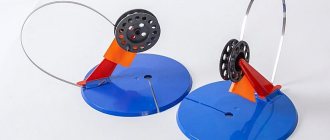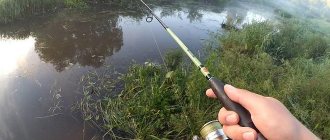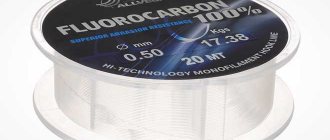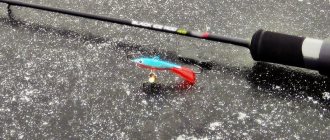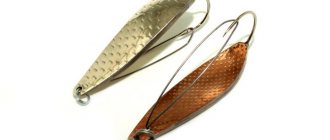Not all live baits for pike are equally catchy. Few experienced fishermen who practice summer and winter bait fishing will argue with this fact. And it often happens that pike literally stand in line for one type of live bait, but simply do not pay any attention to another type of bait, not perceiving it as an object for hunting. Of course, pike whims can depend on a large number of different factors. We, fishermen, can only guess about the existence of some, but we simply don’t know anything about others. But in order to have a good catch in the difficult winter period, you need to adapt to the whims of the pike.
At first glance, there are not so many requirements for live bait for winter pike fishing on girders. Live bait must, firstly, be mobile and lively, and remain active for as long as possible. Secondly, stay alive throughout the entire fishing trip, i.e. at least for one day. Thirdly, the size of the live bait used must correspond to the size of the expected pike that is dominant in this particular body of water. For example, if a pond is inhabited mostly by small pike from a kilogram to one and a half kilograms, then there is no point in offering it live bait larger than 6 - 8 cm, otherwise there will be many empty bites.
Almost any living fish fits these general standards. But, when going in winter with pike fishermen, we have long made it a rule to have a variety of live bait in stock - at least 2 - 3 species (photo 1). After all, you never know in advance what kind of live bait the pike will prefer today.
Photo 1
Live bait size
My passion for fishing in winter with lures began in school. And an excellent training ground for this turned out to be a rather large and deep pond that surrounded our village like a horseshoe. The pond was literally filled with pike, and there were specimens weighing 5 - 7 kg. But in just a few years of my practice of girder fishing, the voracious pike managed to eat all the local crucian carp, so only the round, plate-like hulks of crucian carp from half a kilogram and above were adjacent to the toothy one.
But bait-size crucian carp are hard to find during the day. It was necessary to stock up on live bait in advance, and this was a very troublesome task. While it was still warm in the autumn, on weekends I rode a bicycle to a steppe pond located several kilometers from the village. There were no pike in it, but palm-sized carp were found in abundance. They were excellently caught with a float rod until the onset of cold weather, and two or three trips to that pond were enough to stock up on crucian carp in abundance. I planted them in a large barrel, which was located in the basement of the house, and changed the water to fresh water once a week.
I didn’t feed the fish with anything, because... When feeding, the water turned sour very quickly - and it had to be changed many times more often. But even without feeding, the crucian carp felt great, the mortality rate was very small, and the fish caught were quite enough for the first half of winter. In February, the wilderness set in, fishing conditions became more difficult, and the pike bite deteriorated significantly, so fishing with girders stopped. But with other fishermen I knew, crucian carp, stored in the fall, survived until spring under the same storage conditions.
Nowadays it’s much easier with live bait - any self-respecting fishing store always has live fish in stock, and sometimes even in a wide variety. Moreover, on the roads leading to the most popular pike reservoirs, retail outlets have recently appeared that sell fishing goods, including live bait, around the clock. It’s very convenient: when you go fishing, you buy fresh and lively bait. And you don’t have to bother with storage or worry that the live bait will fall asleep on the eve of going to the reservoir or won’t survive the long journey.
But my wife and I adhere to a simple rule: stock up on live bait on the eve of fishing in advance, and not at the last moment. And if fishing is planned for Saturday, then we buy live bait on Wednesday or Thursday, because even on Friday evening, live bait tends to “unexpectedly” run out. Well, about three dozen fish calmly wait for a couple of days on the loggia in a 60-liter plastic tank (photo 2). Once a day we change their water to fresh water, and, as needed, turn on the aquarium aerator, which pumps in fresh air.
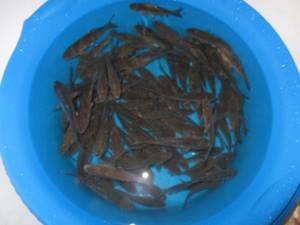
Photo 2
And a long time ago we abandoned the preparation of live bait at the fishing site. Although there is a rule that a predator takes best on the live bait that lives in the same body of water with it. There is a rule, but it’s not always possible to follow it. It’s good if you managed to arrive at the pond before dawn, and the small fish began to bite immediately, without being capricious. But such favorable conditions rarely develop, and you have to spend a long time looking for holes in which you find a fish of the required size, entice it with bait, and persuade each specimen to bite.
The canal is filled with live bait very slowly, the pike bite time is running out inexorably, and the bait baits haven’t even been placed yet... How many times have we found ourselves in such a situation when bait fishing was ruined due to the fact that the candidate for live bait was on strike! Therefore, now we come to pike reservoirs with purchased live bait, set up the girders, and only then catch local fish, and make replacements as necessary.
Our rating of pike baits
Tackle
Catching pike with live bait does not require the angler to have expensive gear or use equipment that is difficult to make on his own. All you need to know before making tackle is to use a high-quality and reliable hook and use a metal leash
.
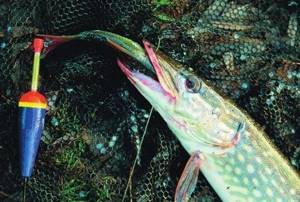
The most common methods are to catch pike with live bait using a float rod, girders, bottom and mugs. I have already written an article entitled catching pike with mugs, but we will still pay attention to the equipment of all the gear and provide a video to raise the interest of our dear readers.
Float rod
Pike is a very strong predator, so the fishing rod must be strong and powerful enough so that it does not break at the most crucial moment. Very often you can catch a decent trophy, and a simple rod may not withstand heavy loads, and the predator will resist until the last jerk. For live bait fishing, float tackle must have the following characteristics:
- The length of the rod should be 5-6.5 meters.
- It is necessary to choose a high-quality fishing line with a diameter of at least 0.3 mm.
- The equipment requires the use of a large float with two attachment points (top and bottom); a sliding float is not suitable for such purposes.
- The hook size must be selected in accordance with the size of the bait used.
- The use of a metal leash is mandatory.

Gear for catching pike with live bait with a fishing rod is quite simple to manufacture and there are no fundamental differences in the structure of the equipment
. Only the thickness of the line, the size of the hook and the float change. I think absolutely everyone knows how to make a simple float tackle.
When fishing, try to cast the tackle as close as possible to a promising place. If you are going to fish in a body of water with a current, then lower the line until you can control the behavior of the gear. After that, cast the tackle again. Usually the predator makes itself known in the first 5 minutes of fishing; if within 10 minutes the bite does not occur, then it is worth changing the place of fishing.
Zherlitsy
The zherlitsa has a very simple structure and can be made independently, even right on the pond while fishing, it will not be difficult even for beginners, you just need to have all the necessary materials with you. Quite often, anglers catch pike with girders in winter; less often they are used when fishing for pike with live bait in open water.
Elementary zherlitsa
for such fishing it is very simple: you need to take a stick 1-3 meters long (depending on the fishing conditions), and tie a thick fishing line with a diameter of about 0.35 mm to its edge. We tie a metal leash to the fishing line, to which a hook with bait bait is then attached. If required, tie a sinker or a metal nut to the rig.
Now you need to secure the tackle in a promising place. Often fishermen install it late in the evening and come to check it in the morning. If you plan to fish in snags, then you need to select the length of the line so that the predator does not tangle the line on obstacles after biting.
If the bank is steep and it is not possible to drive a stick into it, then you can mount the perch on the branch of a tree growing near the reservoir.
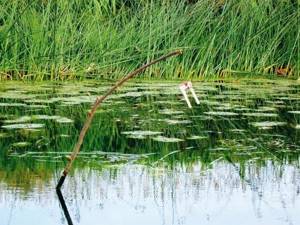
If you plan to fish in winter, the design of the gear changes greatly; we will talk about this in another article, since the topic is quite extensive. Sensitive, convenient and simple gear for passive fishing for predators is perfect for fishing in any body of water.
Donka
Usually, catching pike with live bait using bottom bait occurs in hard-to-reach places where fishing with float gear or fishing rods is not possible, or is very complicated. Most often these are whirlpools and river holes. This gear has not received the popularity it deserves, but let’s give it a little attention.
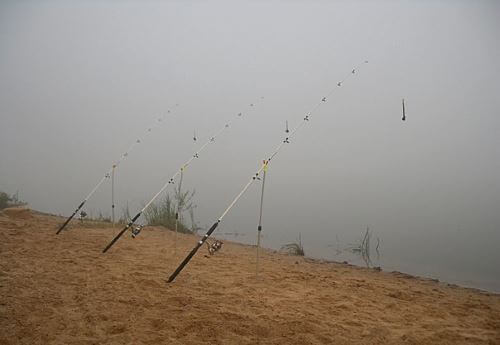
For such equipment it is necessary to use a strong spinning rod of short length. There are no special requirements for the reel used, the main thing is that you can cast the tackle with it over a sufficient distance. About 100 meters of fishing line with a diameter of 0.3-0.4 mm is wound onto the reel. On the fishing line you need to mount two sliding weights (preferably olives) with a total weight of 20-30 grams. A leash with a hook must be attached to the end of the fishing line.
It is best to equip the donka with a metal leash; some fishermen use very thick fishing line, but I do not recommend testing the teeth of a predator. It is better to use single hooks for catching pike with live bait, approximately 7-10 numbers according to domestic numbering.
Mugs
You can find a lot of differences between circles and girders, but the fishing tactics are completely identical. The circle also has a fairly simple structure - it is a foam circle with a groove inside, on which about 10 meters of fishing line is wound. Instead of foam, any materials with positive buoyancy can be used.

Catching pike with live bait using such equipment can be done from a boat in reservoirs with or without current. The fishing technique is very simple and intuitive, all you need to do is put live bait on the hook and lower the circle into the water, as shown in the video. As soon as the bait reaches the bottom, the fishing line must be reeled in 1 meter. The weight of the sinker must be selected in accordance with the fishing conditions and the size of the live bait.
Now you just need to leave the circle floating freely and wait for the predator to attack the bait. The toothy one will attack the baitfish and will try to swim with it to a safe shelter. As soon as this happens, the circle immediately turns over and the fishing line begins to move freely from it. Noticing an inverted circle, fishermen swim up to it and make a sharp hook.
To guarantee a large catch, it is recommended to install several mugs. Fishing regulations in your area may limit availability.
crucian carp
The most commonly used live bait when fishing for pike is crucian carp (photo 3). And, I think, not only with us. Because it is relatively easy to catch such live bait yourself, and in fishing stores crucian carp is found much more often than others and is cheaper. But the most important thing is that it is very difficult for a pike to pick off a crucian carp set behind the back due to the dense and bony meat in which the hook sits securely.
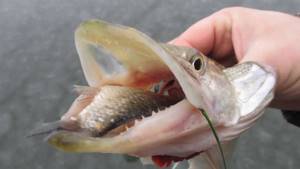
Photo 3
I remember one unusual method of catching live bait, which can be adopted during the period of first ice. The pond where I fished for pike during my school years had a fairly large but shallow bay. When frosts began, this bay was the first to be covered with ice. By autumn its depth was less than knee-deep. And it was here, on this shallows, that the crucian carp, the size of an index finger, miraculously survived over the summer, hid from the pike’s teeth.
When the young ice could already support a person, but at the same time sagged and cracked, we came here with axes and cut small holes. After that, we simply stomped between the holes in such a way that water flowed out of them onto the ice. Along with the flow of water, there were also crucian carp on the ice, which had to be collected before they swam back into the hole. The live bait obtained in this unusual way was just enough for several fishing trips on the first ice.
And crucian carp are not at all picky about storage conditions. With us, they feel comfortable in a tank of water, even without turning on the aerator. And in the store where we buy live bait, they are generally stored on the shelves of the refrigerator in small plastic containers, and the density of the fish is like that of sprat in cans.
Crucian carp are very tenacious, and when hooked correctly, they remain active for several days. Sometimes crucian carp do not die even after several pike bites - this fish is so resilient! It also happened that after an unsuccessful girder fishing, we removed the failed crucian carp from the gear, brought them home - and they lived quietly for a week or two until the next fishing, even with pierced backs.
In general, crucian carp could be called an ideal live bait, if not for one “but”. Despite the fact that this fish is quite widespread, and it is difficult to find a body of water in which crucian carp is not found, pike are not readily caught with it everywhere. According to our observations, the spotted predator is good at catching crucian carp only soon after the ice has formed, when it begins to eat. In the second half of winter, when the bite becomes noticeably worse, pike respond well to crucian carp only under favorable conditions - for example, during prolonged thaws, when its appetite improves. The rest of the time it is better to offer her another live bait.
Here is an example from last winter. At the end of February - beginning of March, the pike bite in our area is very strongly tied to the evening and morning dawn, when several bites in a row can happen in the deep twilight, but during the day you may not even wait for the flag to rise. Therefore, we use under-ice structures of vents (so-called supply structures), leaving them overnight.
One day we set up our fishing rods in the bay, where another fisherman also placed flags. We used crucian carp as live bait, and in the morning we did not find a single triggered bait. But the neighbor took several large pikes from his fishing rods that had caught roaches. According to him, he has long noticed that closer to spring the pike almost does not take crucian carp. Therefore, he is not lazy to travel two dozen kilometers to the neighboring Volga Bay, where small roach are caught well. Such time expenditure is fully justified.
And another typical example. That fishing took place on the pond in mid-January. We set up 8 zherlits, loaded them with crucian carp brought from home. The pike didn't take it, and we decided to catch local bait fish. After much torment, we persuaded one palm-sized perch. It was a bit large for a pike, but there was nothing to be done - they baited one girder with it. And it was on this tackle that the only bite that occurred all day was a pike over a kilogram. Alas, it was not possible to catch any more local live bait, and the pike flatly refused to bite on crucian carp.
And one more main disadvantage of crucian carp: despite the fact that the fish remain alive on the hooks of the girders for a long time, they very quickly lose their motor activity - and hang completely motionless on the tackle. Perhaps this is why pike take them poorly? When we fish with crucian carp, we go around the girders from time to time, lightly tugging on the line and forcing the crucian carp to move. Very often, immediately after such rounds, bites occur (photo 4).
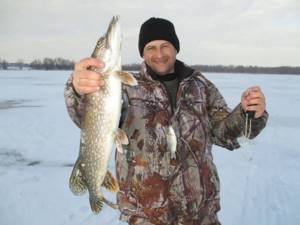
Photo 4
Choosing a location and tactics
At the beginning of the ice season, pike still stay in the coastal zone. This is usually a channel edge behind a strip of coastal vegetation, thickets of sedge and reeds also along the slope to the channel pit. In addition, pike actively hunt in patches of shallows among deep holes. If we talk about the flood zone of the Cheboksary Reservoir, then the predator is still hunting there in the snags of the coastal zone, often going out onto the beds of flooded rivers and streams.
In the middle of winter, pike go to deep places, away from the shore. If we talk about the Volga reservoir, the predator now stays closer to the fairway and in the channels closest to the Volga between the islands. In the “deaf winter”, when the pike often just stands in one place, it is necessary to rearrange the girders from time to time in order to slip live bait “under the nose” of the pike dozing near a snag. This tactic often brings in all the loot. As a rule, after a pike is caught in one place, there is no need to wait for the next predator; it will not soon occupy this hunting area. Therefore, running girders are the most reliable way of fishing in the “dead winter”, although it is a troublesome method that requires strength and desire to constantly rearrange the gear.

Roach and rudd
The best, in our opinion, live bait, which you can find in a store or catch yourself in almost any body of water, are roach and rudd. These live baits are often sold mixed in fishing stores, since they seduce pike equally well. They are universal because they attract pike in almost any body of water. They live long on a hook and are active and mobile.
The pike swallows such runaway soft fish confidently and willingly. They could be called the most suitable for zherlitsa, if not for their poor survivability during storage. It is advisable to catch or purchase such live bait right before fishing, because... storing them at home is associated with certain difficulties. These fish are very demanding of the oxygen content in the water, so they need to change the water much more often than crucian carp - at least twice a day, and the aquarium aerator must be turned on constantly. And during transportation, if the road to the reservoir is long, you need to pump air into the channel from time to time. An ordinary syringe is best suited for this.
Roaches and rudd are the first to be sorted out in stores, and if we were unable to buy such live bait, then having arrived at the reservoir and loading the placed girders with imported crucian carp, the first thing we do is try to catch local roach. Fortunately, these fish, especially small ones, are not very picky when it comes to biting, and are caught almost all winter (photo 5).
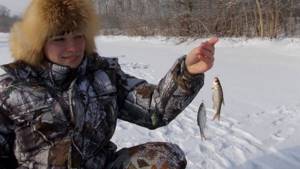
Photo 5
Bleak
Sometimes in stores you can find top melts or bleaks. And sometimes these baitfish really “shoot” at the pike. But their use is associated with many difficulties that lower bleaks down in the ranking of pike live bait. Firstly, it is difficult to store them at home. Bleak is a very tender fish. And if roach can at the very least be preserved for up to one week, although this involves considerable trouble, then bleak is unlikely to be preserved for longer than three days. And it’s not a fact that after you have groomed and cherished them, counting the days until fishing, they will not float up belly up in a cramped and stuffy canal on the way to the reservoir.
Secondly, on the hook the bleaks behave very mobile, but they run out of steam too quickly and fall asleep. Therefore, such live baits have to be inspected and changed every 1 - 2 hours. And their third drawback is the softness and tenderness of the flesh, which is why small pike and even perches tear bleaks and topwater fish off the hook with impunity.
If we come across bleaks among the local live bait, then we load a couple of baitfish with them, and sometimes this really gives a positive result. But a couple of years ago, the use of bleaks played a cruel joke on us.
My wife and I planned to leave the girders for the night, but we still couldn’t catch any live bait. We had almost said goodbye to our idea when, in the evening, we came across an old hole with traces of complementary food, where we quickly brought in the required number of small bleaks. We loaded our girders with them, because there was nothing to choose from anyway. And in the morning, when we came to check the gear, we saw that almost all of our fishing rods were unwound, the live bait was either torn off or worn out by perch teeth. Apparently, already at sunset the perch went hunting - and had a great feast on our bleaks...
Gustera
Recently, in our local lakes there have been a lot of small silver bream the size of half a palm. We have always considered the silver bream to be a third-class live bait. Firstly, because although she lives on a hook for a long time, she is not very active.
Secondly, the wide shape of the silver bream does not facilitate easy swallowing by pike - and hence the frequent idle bites, when the predator crushes and then throws the live bait. The only plus is that the silver bream holds perfectly on the hook: if you pierce it under the dorsal fin, then the predator practically does not manage to rip it off. For a long time we underestimated these live baits, using them only when we were unable to catch roach, rudd, or even bleak. And according to our observations, the pike took worse on the fly. But after a few years, lake pike became so accustomed to feeding on silver bream that they began to ignore all other types of baitfish (photo 6).
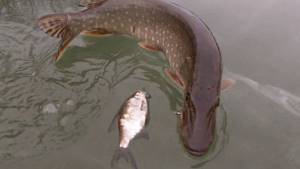
Photo 6
It was here that the rule manifested itself in all its glory that a predator best takes the live bait that constitutes its natural food supply. Therefore, if there are a lot of young silver bream in the reservoir, we safely load our girders with this particular live bait.
Perch
In our opinion, juvenile perch is also an underestimated species of live bait among garrison fishermen. We haven’t seen perches in stores, probably because they are poorly preserved. But at a fishing spot, catching perches the size of your index finger can be quite easy (photo 7), but many fishermen are disdainful of such live bait - they think that pike avoid eating perch because of its sharp spines. And in vain! On girder tackle, perch is tenacious and agile.
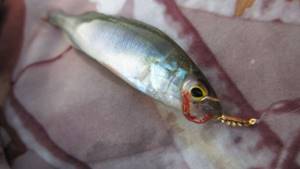
Photo 7
We have already given an example above, when out of eight girders for the day, only one brought a catch, on which the crucian carp was replaced by local perch. We also had another typical example when our baits were loaded with roaches, but there was no bite. Then we caught small perch, and for variety we loaded some of the girders. It was on these tackles that several bites occurred, and the pikes grabbed the same perches several times, even after the fish no longer showed signs of life. Unfortunately, it is very rare for perches to “shoot” so clearly, but sometimes their use can save fishing.
Perch - winter bait fish for pike
Perch can hardly be called the best live bait, but in many closed-type reservoirs, perch is the few, if not the only, representative of cold-blooded fish that can be used to load winter fishing rods for catching pike.
During the winter, you can guess at several periods when the pike has a real hunger for winter baits, but catching live bait from representatives of the “white fish” can be very problematic at this time.
But you can catch small perches in the shallows for equipping the tees of winter girders for catching pike with red-finned live bait without much difficulty.
The good thing about perch as live bait is that it tends to go to the bottom of the reservoir. Therefore, fishermen practically never have problems with fishing line tangling on a winter fishing line when fishing for pike with live bait. In addition, perch, unlike roach, lives for quite a long time when wounded by a hook.
When catching pike with winter and summer poles (circles, stands) near snags, one should not forget that even small perch set as live bait is also a predator, and therefore tends to go into cover with the threat of snagging the tackle for catching pike with live bait in snags or grass.
For the winter season, grass perch is a good, if not the best, live bait for pike fishing gear installed on the ice of rivers and reservoirs. The fish lives a long time, perch is faster than other small fish and can be caught in almost any winter body of water.
Small specimens of perch no larger than 40-50 grams in weight are suitable as live bait for filling winter baits for pike. Larger live baits, tearing off the signal flags of winter vents from the stoppers, can force the fisherman to run around a lot in vain.
In most reservoirs, catching small perch in the first half of winter does not present any difficulties. Perch gathered in fairly large schools can be found in the coastal zone at a meter depth.
In the same places, mixed with perch, ruffe, roach and other live bait fish of the carp family are caught using bloodworms. So, as a rule, there are no problems associated with filling winter girders with perch and roach.
The best places to live and catch small perch in winter reservoirs are sandbanks, island slopes, thickets of dry reeds, reeds, and snags in shallow water.
Therefore, some fishermen fill their winter pike baits with quickly caught perch, and then during the day, in the absence of pike bites, gradually replace the perch with a roach (roach) caught by this time with bloodworms.
Problems in finding and catching perch, as live bait intended for filling winter vents, arise during the dead winter period in closed reservoirs. But pike, a hardy fish, also feels unwell at this time and becomes passive.
